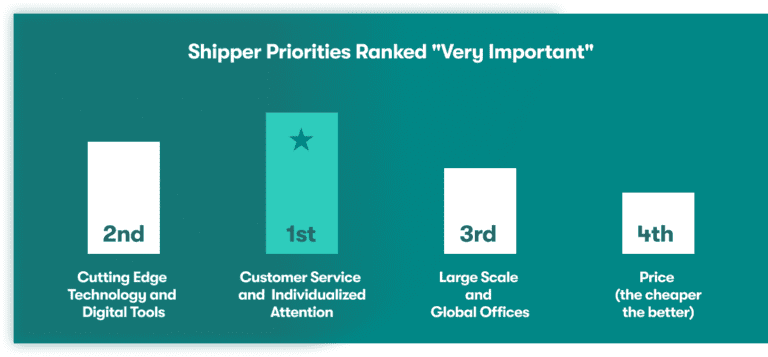In this article
As a wave of digitization sweeps the freight forwarding industry, it can be easy to get overwhelmed. As your list of tech needs continues to grow, you may begin to wonder, “Does this solution have tangible business benefits, or does it just look good on paper?” Some logistics professionals have even raised their doubts about whether adopting tech is critical to succeeding industry, or if it’s all just hype.
In truth, simply adopting the latest technology isn’t a selling point in itself. Leveraging that tech to improve efficiency, customer experience, and business insights is what really sets you apart from the competition.
In this article, we’ll talk about the trend of digitization in the freight forwarding industry, how you can use tech to improve your business, and how to measure that impact.
The trend of digitization in freight forwarding
Digitization is a relatively new (and rapidly expanding) trend in the freight forwarding industry. While the majority of logistics providers were operating with snail mail only a few years ago, many have since transitioned to digital TMS solutions and increasingly advanced technology.
While it may be easy to write this trend off as a “follow the leader” scenario, there’s reason to believe there’s more to it than that. For one, freight forwarders are facing rising pressure from customers to get their tech in order. According to a survey conducted by FreightWaves and Logixboard, 46% of shippers have stopped working with a freight forwarder in favor of a provider with better technology.
However, in the complex world of freight forwarding, the possibilities for what to optimize are endless. In turn, many logistics providers struggle to decide where to invest their time and money first, especially when their idea of what’s “most critical” may not line up with their shippers’ perspectives.
In the FreightWaves/Logixboard survey, shippers rated “online quotes” as the most important digital capability, followed by “shipment visibility,” “document digitization,” and “analytics and reports.”
With a mix of software solutions (ERPs, TMSs, CX platforms), forwarders are starting to streamline and automate a variety of day-to-day operations, including many that shippers deem most important. In this stage of the industry’s digital transformation, tech-driven companies are increasingly leaning into features like automation, data analysis, visibility, and more.
With these developments, logistics professionals are beginning to improve efficiency and expand capabilities in ways that weren’t previously available. However, cutting-edge technology still doesn’t solve for a weak business plan or poor operations. In other words, purchasing solutions without a reason or strategy will just recreate your paper mess in a digital system.
How to make your tech work for you
There’s no question that modern technology has the potential to take a business to the next level. After all, advancements in data analysis, storage, and automation have enabled digital systems to complete manual tasks in a fraction of the time it would take a human– and at a fraction of the cost.
However, in order to achieve the desired effects, you need to know how to leverage your technology– and how to lead your team to do the same.
Avoiding the common pitfalls of technology
Adopting change can be difficult in any organization. When introducing brand-new tech to a company that’s accustomed to an outdated system, there are a few common mistakes that leaders can make.
1. Going for “the best solution” instead of the one that fits your business needs
Many business leaders are accustomed to budget being the main constraint in company decisions. Therefore, when given the funds, they’ll aim to find the “best” solution there is to get the job done. However, the top-rated or most expensive software isn’t always the right choice for your company or goals at the moment.
With that in mind, it’s important to narrow down your company needs before choosing a digital provider. By working with your team to figure out what you’re looking for, you can decide what features are most important to you.
Here are some key questions you can bring up to kick off the conversation:
- How many team members are involved in the forwarding process?
- What’s the average level of technical know-how on your team?
- What task does your team spend the most time on (ex: data entry, document creation, responding to emails)?
- What’s the biggest factor in customer churn at your company?
- What digital features do your customers most want to see?
Once you have a clearer picture of your ideal solution, you can start to narrow down your list and book demos to compare your final options.
2. Neglecting change management
Despite efforts to recruit younger demographics to the logistics industry, the fact remains that the average logistics professional is more accustomed to traditional processes than advanced software. Therefore, implementing new technology means more than just downloading it onto your system. You also need to train your employees on how to use the program, and how it fits into the broader goal of improving your operations.
By adopting the right change management strategies, you can set yourself up for a smoother implementation– thereby improving employee satisfaction, boosting ROI, and decreasing time to value.
3. Failing to solve for the #1 limiting factor
As digital communication becomes the norm across workplace settings, we’ve come to accept it as an efficient alternative to face-to-face conversations. And certainly, online messaging and virtual meetings have their benefits, from cutting down scheduling friction to enabling remote work.
However, at some point, all that technology is accomplishing is making people more accessible. In an article by Harvard Business Review, Bain partner Michael Mankins criticized this trend, saying, “As the cost of communications decreases, the number of interactions increases exponentially, as does the time required to process them.”
In other words, when streamlined communication is the leading tech by an organization, it can actually slow you down by incentivizing employees to create more meetings due to convenience. That’s why it’s important to supplement these solutions with features that augment your team’s efforts, such as automation or data analysis.
Building a cohesive tech stack
Finding and implementing a single solution isn’t the same as undergoing a digital transformation. Rather, creating a tech stack that works well together is key to achieving our desired outcome.
Building a powerful tech stack is no easy task. For one, you need to make sure your digital suite covers all of your processes. It’s unlikely that you’ll be able to find one software to fit all of your needs, so you may need to divide and conquer.
Many freight forwarders leverage an enterprise resource planning software (ERP) or transportation management system (TMS) to manage back-office operations. Some will also adopt a customer experience platform to collaborate with customers more effectively.
Keep in mind that not all ERPs, TMSs, or CX platforms are made equal. Every software will have its own feature offerings, advantages, and shortcomings. That’s why it’s important to do your research to find the one that’s best for you.
Regardless of which solutions you choose, finding a way to connect your tools is key to running a well-maintained system. While some may have their own built-in integrations, others will require more in-depth planning to make them work together successfully.
Enabling personalization and relationships
When you begin your digital transformation, one of the first things to understand is that you can’t run your business on software alone. Rather, you need to use your technology to handle what it does best, like automating repetitive tasks or creating standard documents. In turn, you’ll free up time for your people to handle more complicated work, such as negotiating better shipping rates or meeting with prospective customers.
In the FreightWaves/Logixboard survey, 78% of shippers rated “customer service and individualized attention” as Very Important when working with a freight forwarder– even higher than technology and price.

By assigning tedious work to your software tools, you can speed up your processes and reduce human error. At the same time, you’ll be able to continue providing your customers with the same personalized service they’re accustomed to– or even more.
How to measure the impact of your technology
Using your tech strategically is key to gaining a competitive advantage in the industry. But how will you know if it’s working unless you measure its impact?
Before implementing your software, decide on a few key performance indicators (KPIs) that you’d like to improve. These metrics will vary depending on what area of business you’re focusing on. For instance, if your primary goal is sales enablement, you’ll want to measure indicators like revenue, churn rate, and quote conversion ratio. On the other hand, a business focused on efficiency might pay attention to accuracy and productivity metrics.
In addition to using this data to evaluate your tech internally, you can also leverage it to win new business. As you identify improvements from your new solutions, you can work your findings into sales enablement meetings or quarterly business reviews.
Final thoughts
Adopting modern technology is instrumental in getting ahead in the freight forwarding industry, as long as it’s executed properly. Avoiding tech pitfalls, integrating your solutions, and dividing work effectively will give you a strong start for your digital transformation.
Learn more about how to build an effective software stack with our Logistics Tech Scorecard.

